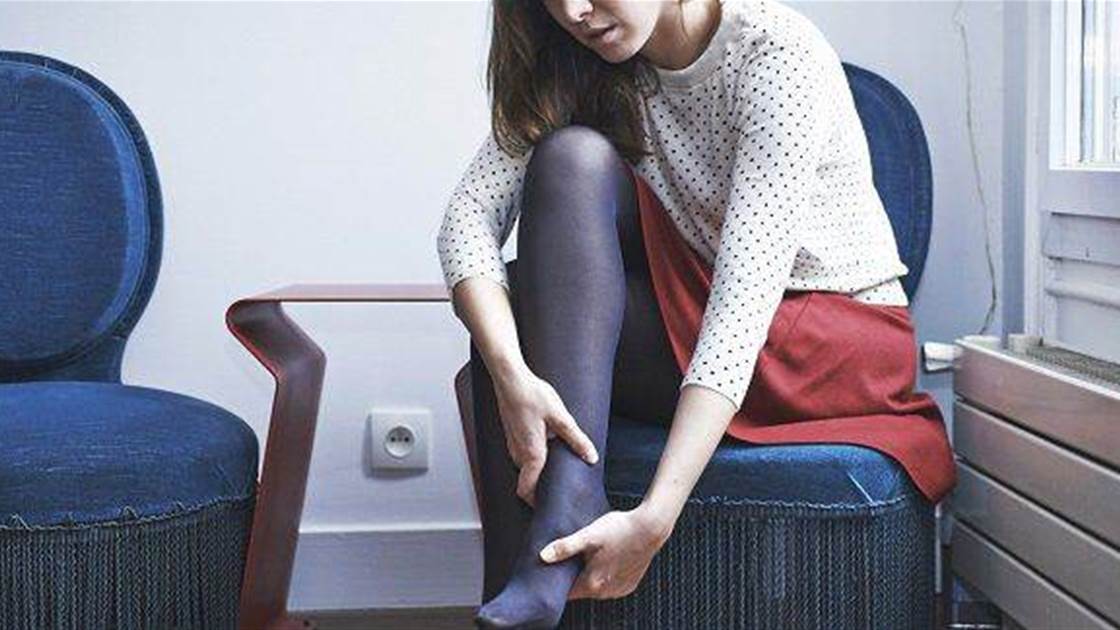Walking is lauded as one of the easiest, most effective, and most accessible forms of exercise, and that's true-as long as you're not dealing with foot pain that makes every step agony. Around 40% of Australians will experience some form of foot problems in their lifestime, which means that for many of us, going for a walk may be a lot less appealing than sitting on the couch.
"The foot has almost as many bones as the hand and wrist, so it's a complicated piece of real estate," says physical therapist Rick Olderman. "Yet we don't pay much heed to our feet until there are problems."
For women, this may be particularly true. According to a recent survey, women are nine times more likely to develop a foot problem than men are, likely because nine out of 10 women wear shoes that are too small for their feet. The result? More than seven out of 10 women develop conditions like bunions, hammertoes, or other painful foot deformities-all of which can take the spring out of your step.
What's a walker to do-especially if she's an unabashed high-heel lover? "The first step in fixing chronic foot pain is to understand why you're having it," says Olderman. Here, the seven most common issues that keep women from pounding the pavement, and what to do for happy feet once again.
Plantar fasciitis
"This is by far the most common problem I see in my middle-aged patients," says podiatrist Jeffrey Oster. Plantar fasciitis is an overuse syndrome that causes painful inflammation of the band of fibrous tissue that runs along the bottom of your foot (called the plantar fascia). "You don't find plantar fasciitis in children-they heal too quickly. And you don't find it in older folks because they're not out there doing activities that would contribute to it," says Dr Oster. Yet if you're somewhere in the 40- to 65-year-old range, you may be more likely to experience heel pain, especially if you're carrying around extra kilos. "The force on your feet is about 120 percent of your weight," Dr Oster says. "Over time, that causes the tissue in the foot to become less elastic," leading to pain.
The fix: Massage and stretch your feet and calves.
Not only can this help relieve inflammation by prompting a fresh supply of oxygenated blood to rush to the area, but massaging and stretching may also lengthen the plantar flexor muscles, helping them move more freely and with less pain, says medical massage therapist Rachel Scott. "People tend to focus solely on the bottom of the foot and forget that the plantar fascia is part of a system that starts with the calf muscles and continues through the Achilles tendon," says Scott. (Ease the pain with these 3 exercises.)
Bunions
With bunions, a firm, painful bump develops at the base of the big toe, sometimes causing that toe to veer diagonally toward the second toe. Bunions can get worse if you consistently wear too-tight shoes, says holistic podiatrist and fitness specialist Suzanne Fuchs. "These joints commonly become painful when shoes rub against them and cause inflammation, swelling, and redness," she says.
The fix: Choose the right shoes.
To help prevent bunions in the first place, make sure you're wearing shoes with a wider toe box, says Dr Fuchs. There should be about a half-inch of space between the tip of your longest toe and the end of the shoe. "Your shoes shouldn't cause too much pressure on your feet and toes or cause them to crunch up," she says. You might also add specific padding to help alleviate calluses (caused when these enlarged toe joints rub against your shoes), or add orthotics to your shoes, says Dr Fuchs. "These can improve the biomechanics of the foot, helping to balance the muscles and tendons and stop bunions and hammertoes from worsening."
Hammertoes
A hammertoe is a foot deformity, in which there’s an abnormal bend in the middle joint of your toe. Hammertoes happen when there’s an imbalance in the muscles of your foot. Podiatric surgeon Jacqueline Sutera says, “You have muscles at the top and bottom of your feet. If one of those muscle groups is stronger than the other, it may result in a hammertoe.” The toe becomes crooked because one of the toe muscles becomes weak, which puts pressure on the tendons and joints in one or more toes. This causes the toe to stick up at the joint.
Dr Sutera says that wearing poorly designed shoes that don’t fit your feet, incurring an injury such as stubbing your toe, and having a family history of hammertoe are common causes. People with hammertoe are also prone to developing corns and calluses, she adds.
The fix: Use non-medicated corn pads.
“I recommend my patients to use non-medicated corn pads because they provide support and cushion while helping to relieve pain and prevent friction,” Dr Sutera says. But she says to avoid using medicated corn pads. Why? “Because the acid in the medication can eat away at your skin and cause bacteria to form, which leads to an infection,” she says.
Dr Sutera also recommends using shoes that are appropriately sized and are designed for the activity you’re doing. “Avoid wearing the same kind of shoe throughout the day. Wear commuter shoes on your way to work, but don’t wear your high heels all day,” she says. If the issue worsens and you’re experiencing a lot of discomfort, Dr Sutera says to consider surgery. “It takes 15 minutes, you’re under local anesthesia, and it’s covered by insurance,” she says.
Flatfeet
Flatfeet happens when the arches of your feet have been flattened. Many people are born with flatfeet, but you can also develop it later in life due to direct trauma to the posterior tibial tendon, which is the tendon that attaches your calf muscles to the bones on the inside of your feet. “If you do high-intensity sports or exercise, the posterior tibial tendon can be overused and inflamed. You can develop flatfeet because of this,” Dr Sutera says. She also says people with flatfeet are prone to developing fasciitis and bunions.
The fix: Wear orthotics.
“The best thing to do is to wear appropriate shoes and orthotics, which forces your foot to walk with an arch,” Dr Sutera says.” Orthotics will also help absorb shock from walking or running and help prevent pain in the ankles, knees, and back, which are affected with flatfeet.
Calluses
While most of us think of these areas of thick skin as simply unsightly, calluses are pressure spots that can be painful when you walk, says Dr Oster. Interestingly, they're actually the body's way of preventing painful blisters from developing. Without a callus, the pressure and friction would irritate your skin to the point of creating those painful, fluid-filled bubbles you know as blisters. However, that doesn't help if your calluses-oftentimes on the ball of the foot, the heel, or the top of bunions or hammertoes-keep you from walking or running around comfortably.
The fix: Soak, then soften.
To treat calluses at home, soak your feet in warm water and then apply a moisturising lotion that's loaded with glycolic acid, lactic acid, or urea. These ingredients can help soften the skin and minimise the callus. If your callus is especially large or painful, schedule an appointment with a podiatrist or dermatologist who can remove it with a surgical blade or give you a shot of cortisone if your pain is particularly bad.
Achilles tendonitis
Your Achilles tendon, which attaches to your heel bone at the back of your foot, can become irritated and inflamed when it's overused, says Dr Fuchs. The result is tendonitis, and runners are particularly susceptible, she says, as are those who regularly wear high heels. Other potential, though not as common, causes include inflammatory illnesses such as rheumatoid arthritis or gout.
The fix: Rest, ice, repeat.
The sooner you nip this problem in the bud, the better, Dr Fuchs says, which is why she recommends avoiding any activity that aggravates your pain for a week to a month. When you feel even a little twinge, ice the area ASAP. Your doc may also suggest you take a non-steroidal anti-inflammatory to ease your discomfort and quiet the inflammation.
Morton's neuroma
This condition causes pain in the ball of your foot that commonly radiates toward your third and fourth toes, says Dr Fuchs. "It can feel as if you're standing on a pebble that's stuck in your shoe," she says. Dr Sutera says Morton’s neuroma is often the result of women wearing high heels or pointy, narrow shoes. “Your metatarsals, which are the bones in your feet, are compressed when you’re wearing tight shoes. They put pressure on the nerves around them, causing a sharp, stabbing pain,” she explains.
High-impact sports like tennis and running can also cause Morton’s neuroma. The repetitive pounding on hard surfaces can cause trauma to the nerves that lead to your toes. People who have bunions, hammertoes, high arches, or flatfeet are also at higher risk for Morton's neuroma.
The fix: New shoes, custom orthotics, and possibly cortisone injections.
One thing you can do for quick relief is to massage the space between the metatarsals, Dr Sutera says. “Take your thumbs and use them to massage the top of your foot and use your other fingers to put pressure at the bottom. Massage spaces in between your toes where the nerves live,” she says.
Make an appointment with your doc to do an x-ray to rule out other problems, and follow up with an ultrasound or MRI, which are better diagnostic tools for revealing soft tissue abnormalities. Then, you may be in for a new-shoe shopping spree, as ill-fitting shoes contribute to your problem and make the pain worse, says Dr Fuchs. "You might be able to try arch supports, foot pads, or custom orthotics, which will help contour and cushion your foot while you walk," she says. Dr Sutera also recommends wearing a variety of different shoes and tossing out shoes with uneven or damaged soles.
If these more conservative tactics don't work, cortisone injections or even surgery to relieve the compression on the nerve could be options.
October 14-20 is National Foot Health Week and Australians are encouraged to ‘Stand Up for your Health’, by knowing where your feet fit in. Head to the website to find out more.









.png&h=193&w=250&c=1&s=1)
